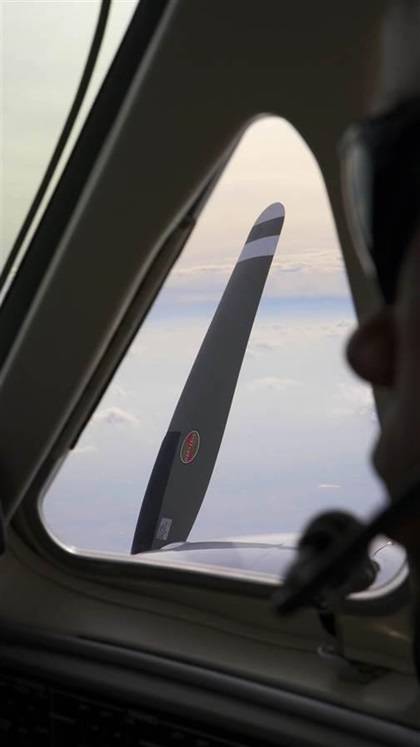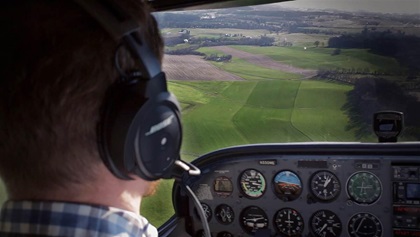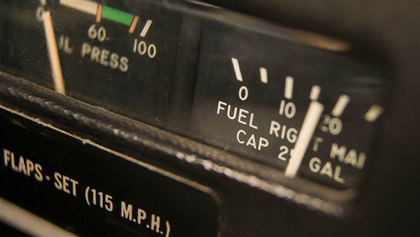Engine out!
A systematic approach to emergencies-from engine failures to fires

In the event of an engine failure after takeoff, how high would you have to be to successfully turn back to the runway? You can practice this scenario at a safe altitude—include a five-second delay to account for the time it takes to recognize an emergency—and note how much altitude the airplane loses in a turn back to the simulated runway. Add a safe cushion and brief that altitude before each takeoff.
Photography by Chris Rose
 Despite the drama, you know Tyukin makes it safely to the ground because this is all months after the fact, offered to the world from the vantage point of a POV camera posted to YouTube. Tyukin’s emergency, like others on the video-sharing site, gives us great insight into how pilots react in real time to serious problems. We can also view emergencies as they happen, rather than in a scenario conjured by an instructor.
Despite the drama, you know Tyukin makes it safely to the ground because this is all months after the fact, offered to the world from the vantage point of a POV camera posted to YouTube. Tyukin’s emergency, like others on the video-sharing site, gives us great insight into how pilots react in real time to serious problems. We can also view emergencies as they happen, rather than in a scenario conjured by an instructor.
The video begins with Tyukin talking about his experience, but the action starts a few minutes later. We see him add full power and initiate a normal climb from Runway 19L at Concord, California’s Buchanan Field. For about a minute he climbs straight ahead. This is an unusually long departure leg, but we learn that he is following a Cirrus that is making a wide pattern. That causes Tyukin to turn crosswind around 900 feet above the ground, about 300 feet higher and that much farther from the runway than is customary. A few seconds later he reduces the power and you can hear a sharp and distinct decrease in rpm, as if an invisible instructor has reached out and pulled the throttle back to idle in a practice session. Then…nothing.
For three seconds Tyukin doesn’t move. He then checks the mixture, fuel, and fuel shutoff. Then he continues flying straight ahead, eyes darting to various instruments and looking outside. It’s around five more seconds before he begins to turn back to the airport. There are a few radio transmissions, but mostly we watch as Tyukin threads his way between tall trees before landing on a golf driving range and slamming into a fence. Roughly three minutes have passed since the airplane’s wheels left the ground and only about 90 seconds since the engine has failed. It’s his third solo flight.
An engine failure after takeoff is one of the most intense emergencies a pilot can face. Without altitude the pilot must immediately assess the situation, keep the airplane flying, and make a decision on where to land in a matter of a few seconds. Other than perhaps an in-flight fire, no situation calls for as much prompt decisive action. It’s one of the many reasons we practice simulated engine failures so much in training. Practicing helps develop muscle memory, and a systematic approach to dealing with emergencies.

Emergency responses can be broken down into a few key steps that help us compartmentalize and clarify our thoughts during these stressful situations.
Recognize the problem and determine its severity
The first step in any emergency response may seem obvious, but recognizing the problem is not always easy. If, in a case like Tyukin’s, the engine spools down and the propeller starts windmilling, it is obvious: There’s a power loss. There are dozens, maybe even a hundred different problems a small airplane can have. Maybe the problem is intermittent, such as a small airframe shimmy. Or it might be catastrophic, such as complete engine failure. The first step of any emergency response is recognizing the problem. Almost simultaneously, you must determine the severity of the problem.
This is a step that’s often skipped in training, but it’s a crucial one. Determining the severity of the problem you’re facing tells you things you need to know in order to solve it. Many pilots fear the worst when faced with even the most basic problems and may end up causing more serious emergencies. The infamous door opening on takeoff is a perfect example. In almost all cases, light aircraft will fly fine with a door open. Yet, pilots routinely take a door popping open to be a grave emergency that must be immediately fixed. Airplanes have been destroyed and lives lost over this. An open door is nothing more than annoyance: a minor problem that must be addressed, but which sits well below aviating, navigating, and communicating.
Knowing the severity of the problem helps a pilot determine whether the situation needs immediate action, an urgent response with some troubleshooting, a more relaxed and thoughtful troubleshooting, or a deferral to a later time. An engine failure at low altitude requires immediate action. A blinking radio display can be deferred until the flight is over. In between lie the many problems that don’t appear on checklists and must be dealt with creatively.
Come up with a solution
Once you know how urgent and critical the problem is, you can begin to work on a solution. Inside the airplane’s handbook you will find checklists and expanded procedures for anywhere from three to 15 abnormal or emergency scenarios. They range from engine fire during start to spins. Checklists are great, but how does anyone expect you to pull out a checklist when you’re in an increasingly tighter spin, heading toward the ground? The answer is that they don’t.
In the airline world, certain checklists are committed to memory and certain checklists are referenced during the troubleshooting. The company dictates which checklists have memory items, and all pilots are expected to adhere to that practice. There’s no reason pilots flying recreationally have to be different. As you look through the handbook, think about which emergencies require immediate action (engine failure, fire) and which allow for more time and troubleshooting (electrical failure, open door). For those emergencies that require immediate action, memorize the checklist or the first few critical items, understanding that you may or may not have time to verify it in an emergency.
Tyukin did a marvelous job of going through the engine failure checklist by memory as a flow. Because he had practiced it many times before, the checklist was almost second nature. He maintained best glide speed, identified a landing site, turned toward it, tried to restart the engine, and then communicated with the tower. In fact, the only thing he missed on the checklist was turning on the auxiliary fuel pump, which wouldn’t have helped anyway. Later sleuthing uncovered that the engine failed as a result of a bad part in the fuel system.
But what if the problem you’re experiencing isn’t on the checklist? Much of what could go wrong won’t be. A jammed trim tab, misaligned flaps, broken throttle cable, flat tires, nicks in the propeller, and all sorts of other potential concerns aren’t spelled out in black and white. For these, the proper response comes down to the severity of the problem, where you are in relation to an airport, the weather, and your proficiency.
Execute the plan
It seems simple enough, right? Once you have identified the problem and come up with a solution, do the solution! You’d be surprised. Sometimes the fear, denial, stress, and pressure of the situation manifest into anything other than action. Pilots have been known to sit and not react, react in random, ineffective ways, or just straight panic. By identifying the problem and coming up with a concrete plan, you can make acting on it easier.
Re-evaluate as necessary
In an emergency, things are constantly changing. A rough engine worsens and resolves, winds shift, traffic and air traffic control are always in flux. Just like a flight plan, an emergency plan is a starting point. As variables change, so too must the plan.
As Tyukin was gliding toward Runway 1L, at some point he realized he wasn’t going to make it. At a low altitude and with little excess energy, he was at the mercy of the landscape. Thankfully the golf course and driving range lay just off the end of the runway, so changing his plan to land short on the driving range was an easy decision.
Sometimes the choice isn’t so easy. Every student pilot has faced the challenge of gliding toward a field in forced landing practice, only to realize that making the chosen field is questionable. Now a decision must be made. Pick a new field or try to make the one you’ve selected? These sorts of split-second decisions are critical. The worst choice you can make is no choice at all. Many emergencies have had bad outcomes because the pilot was paralyzed by a choice and didn’t commit to a new plan. Only experience will help you make the right choice, but even a new student can understand and apply the need to make any choice, and continually re-evaluate it.
It’s impossible to practice every type of emergency response, but by practicing the critical potential problems, committing certain checklists to memory, and going through a reasoned response, your chances of a favorable outcome increase greatly.

 Tips for off-airport landings
Tips for off-airport landings A real-life engine failure usually isn’t the sterile exercise most pilots have come to expect when the CFI reaches over and yanks the throttle. The tachometer probably won’t just drop to 1,000 rpm and remain there. The engine may be shaking—violently, even—and there may be oil on the windshield. Smoke and fire are possibilities. In some cases, the engine may seize. Carburetor ice, cylinder failures, or other problems may cause partial or intermittent power loss. In short, there’s a “reality factor” that can make it more difficult to identify the appropriate action. On the bright side, there’s a good chance that the engine will give hints about its poor health in the hours leading up to a failure—so watch for symptoms such as abrupt changes in oil consumption, unusual engine monitor indications, failure to develop proper static rpm, or unusual noises or vibrations. Get tips for preventing, recognizing, and responding to emergencies in the AOPA Air Safety Institute “Emergency Procedures” Safety Advisor. —AOPA Air Safety Institute staff
A real-life engine failure usually isn’t the sterile exercise most pilots have come to expect when the CFI reaches over and yanks the throttle. The tachometer probably won’t just drop to 1,000 rpm and remain there. The engine may be shaking—violently, even—and there may be oil on the windshield. Smoke and fire are possibilities. In some cases, the engine may seize. Carburetor ice, cylinder failures, or other problems may cause partial or intermittent power loss. In short, there’s a “reality factor” that can make it more difficult to identify the appropriate action. On the bright side, there’s a good chance that the engine will give hints about its poor health in the hours leading up to a failure—so watch for symptoms such as abrupt changes in oil consumption, unusual engine monitor indications, failure to develop proper static rpm, or unusual noises or vibrations. Get tips for preventing, recognizing, and responding to emergencies in the AOPA Air Safety Institute “Emergency Procedures” Safety Advisor. —AOPA Air Safety Institute staff